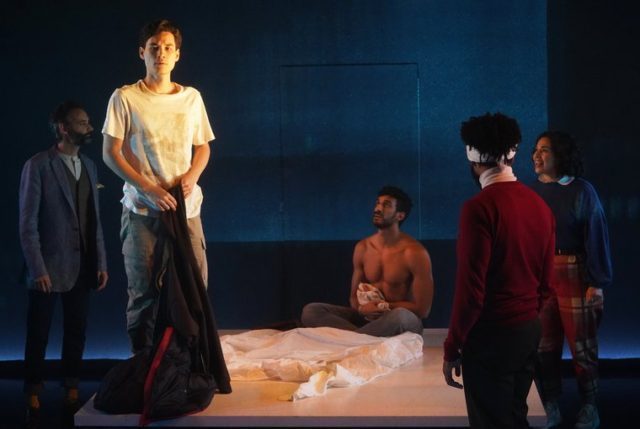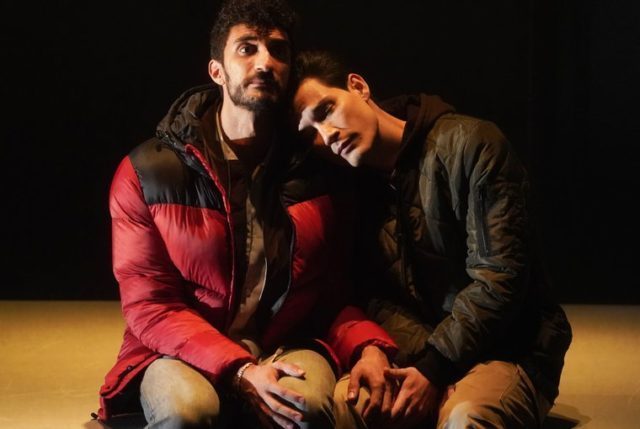
A one-night stand turns into a treatise on love, art, and immigrations in On That Day in Amsterdam (photo by Carol Rosegg)
ON THAT DAY IN AMSTERDAM
Primary Stages at 59E59 Theaters
59 East 59th St. between Park & Madison Aves.
Tuesday – Sunday through September 4, $60-$125
212-279-4200
www.59e59.org
primarystages.org
Immediately after graduating college, I backpacked across Europe with my best friend. We had planned to spend a day or two in Amsterdam, but we were having such a great time, sleeping on a botel and enjoying the vast culture, that we ended up staying a week. The protagonists of Clarence Coo’s poignant if overly earnest On That Day in Amsterdam have no such option.
The ninety-minute play is told in flashback through the somewhat unreliable memories of Kevin (Glenn Morizio), who spends years trying to write the story of what happened “on that day in Amsterdam,” a phrase that begins many of the scenes. Kevin and Sammy (Ahmad Maksoud) hook up at a club and spend the night together on a houseboat. The next morning, Kevin, who is American, claims he has to take off to catch a plane back home, while the smitten Sammy, whose ancestry is less clear, wants to hang out all day with him before he is supposed to secretly leave that evening for the Netherlands and meet up with his brother to find a better life in England.
Sammy wants to get food and visit all the museums they can and eventually loosens up Kevin enough that they begin to do just that, their tale enhanced by third-person narration spoken by Rembrandt (the Romantic One) van Rijn (Brandon Mendez Homer), Anne (the Empathetic One) Frank (Elizabeth Ramos), and Vincent (the Perfectionist One) van Gogh (Jonathan Raviv).
“On that day in Amsterdam, two young men were in a bed and looked at each other in the morning light,” Anne says. “One of them was thinking about the present moment,” Rembrandt adds. “And the other was not,” Vincent concludes.
As they continue on their sadly brief adventure, Sammy and Kevin try to break down each other’s walls as well as those inside themselves.
“Can you relax?” Sammy asks, attempting to take a photo of Kevin, who responds, “I’m trying.” “Smile? No. Don’t smile. Actually, don’t listen to me. Just be yourself,” Sammy advises. “What does that even mean? Be myself?” Kevin wonders.
After learning that they have far more in common than they originally thought, they both prepare to head off to their very different destinations.
“One year from now, one of these two young men will try to write a book,” Anne tells us. “— will begin to write a book,” Rembrandt corrects. “— will write a book,” Vincent says. “And the other will not,” Rembrandt affirms.
Most of On That Day in Amsterdam takes place behind a giant translucent scrim; Kevin occasionally exits through a door at the front and goes to a table with a computer monitor, where he attempts to write his book as the years go by, but he is haunted by what he fears might have happened to Sammy. Much of the action occurs on a platform in the middle of the stage, reminiscent of Martyna Majok’s 2017 NYTW production of Sanctuary City at the Lucille Lortel, which also dealt with family and immigration issues, and Nick Payne’s 2015 Constellations, in which a man and a woman keep replaying scenes from an intermingling past, present, and future. (The Amsterdam set is by Jason Sherwood, with lighting by Cha See, sound by Fan Zhang, and costumes by Lux Haac.)

Sammy (Ahmad Maksoud) and Kevin (Glenn Morizio) wonder what’s next for them in On That Day in Amsterdam (photo by Carol Rosegg)
Morizio and Maksoud form an endearingly tentative couple as Kevin and Sammy, dancing, kissing, shopping, and waiting on line at museums. Coo (Beautiful Province [Belle Province)], The Birds of Empathy) and director Zi Alikhan (The Great Leap, Lady Apsara) repeatedly reference the importance of art, as represented by Rembrandt, Vincent, and Frank, but the emphasis sometimes feels heavy-handed.
“Maybe everyone’s an artist at heart,” Kevin offers. “You think so? Not everyone can be Anne Frank,” Sammy says. “No,” Kevin agrees. Sammy: “She was a great writer. That’s why people remember her.” Kevin: “Sure.” Sammy: “Not everyone can be a great writer.” Kevin: “What I mean is — the instinct to be an artist. The potential? Maybe that’s in everyone. And if people don’t live up to that potential? That’s a waste.”
The show features projections by Nicholas Hussong on the scrim and in the back, from live shots of Sammy considering his fate to colorful images of paintings that resemble works by Rembrandt and Vincent but are clearly not, sticking out like sore thumbs; if the producers couldn’t get rights to the pieces, it might have been better to not include these abstractions at all.
Meanwhile, Kevin declares Sammy is an artist as well, based on one cellphone photo of a swan soaring in the air, later comparing it to Jan Asselijn’s The Threatened Swan, the first work to enter the collection of the Nationale Kunstgaleri, later to become the Rijksmuseum, a canvas that represents the protection of the country from its enemies. Such obvious metaphors fly throughout the play, which succeeds much better when it is goes for a more subtle approach.
It also brought back fond personal memories of that week in Amsterdam I spent once upon a time, where I was privileged to not be in the same situation as Kevin or Sammy.